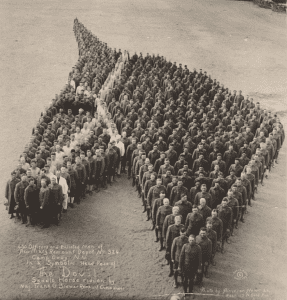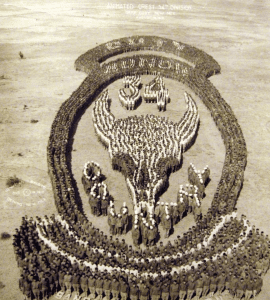The widely circulated image above is often accompanied by captions claiming it depicts soldiers paying tribute to horses fallen in the Great War, but this, unfortunately, is a misinterpretation of history. Eager to set the record straight, let’s delve into the real story behind the photo.
The photograph is part of a series taken by Michigan photographer Almeron Newman, born in 1875. Newman, known for his expertise in panoramic and forced perspective photography, was particularly acclaimed during the era of ‘living photography.’ This technique involved using people to create scenes and objects, aligning with the prevailing fashion of the time. In August 1918, while serving as a military photographer at Camp Cody, an Army camp in New Mexico, Newman captured a striking image of men from the 34th Infantry Division, known as the Sandstorm Division, meticulously arranged to form their divisional crest.

During the war and post-war years, the trend of living portraits gained momentum in America, driven by their popularity in patriotic propaganda. These technically intricate shots commanded a premium from photographers, who could sell multiple copies of the same image.
Now, let’s address the misconception surrounding the photo as a ‘tribute to the horses of WW1.’ Over the years, the image has been reused with misleading information, perpetuating myths. Taken by Newman at Camp Cody in January 1919, the photo features 650 men of the Auxiliary Remount Depot No 326 posing in a symbolic head arrangement resembling a horse known as ‘The Devil.’ This horse belonged to Maj. Frank G Brewer, the Remount Commander. The term ‘saddle horse’ indicates a horse reserved solely for riding, often a favorite mount.

Efforts to find more information on Maj. Brewer have yielded limited results. Intriguingly, the US National Archives has a version of the photograph from 1921, referring to Brewer as Colonel Frank C Brewer. In their version, a photo of a horse is included, likely used by Newman to model the scene, possibly ‘The Devil’ itself. The background of the photo reveals intricate details of the Remount camp with expansive horse paddocks.

Despite the captivating nature of the photograph, there is no evidence supporting the notion that it was taken as a tribute to the millions of horses that served in the Great War. Nevertheless, it provides a glimpse into one of the largest remount depots in America during the immediate post-war period. Ideally, with time, the myths perpetuated on platforms like Twitter and Facebook will dissipate, allowing us to appreciate the image for its historical context, shedding light on the history of Camp Cody and the noteworthy work of the U.S. remounts.
